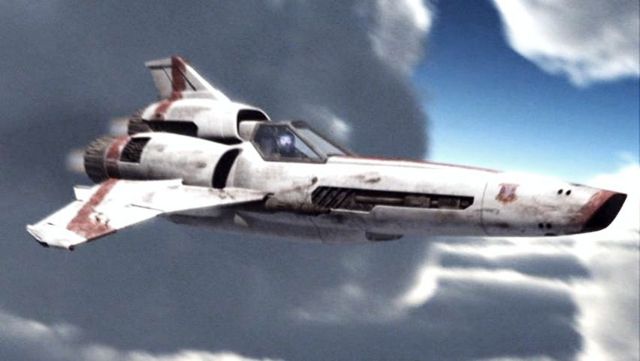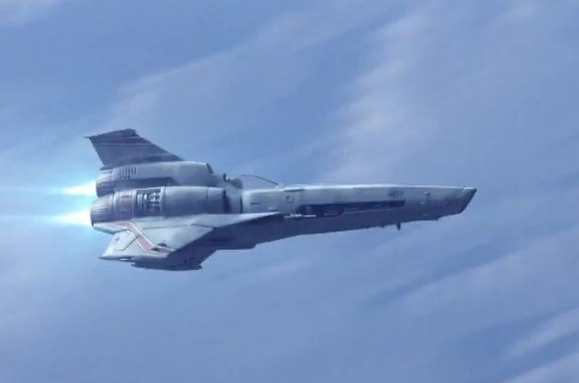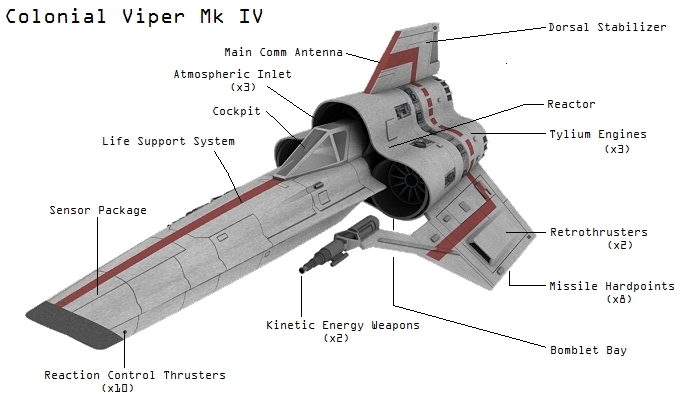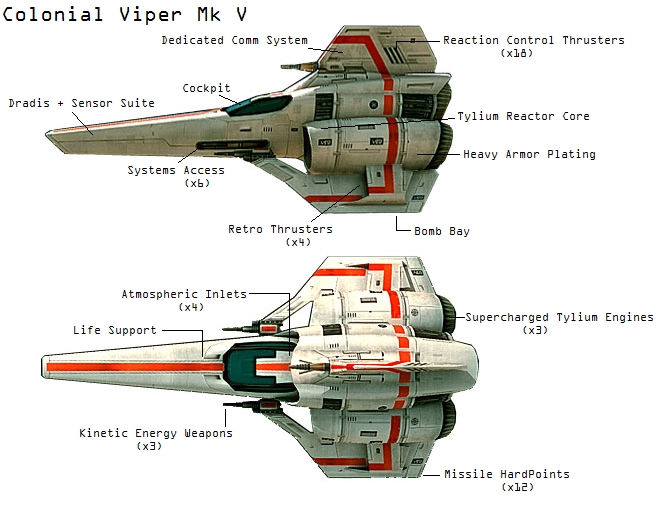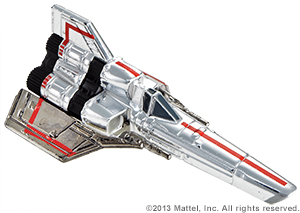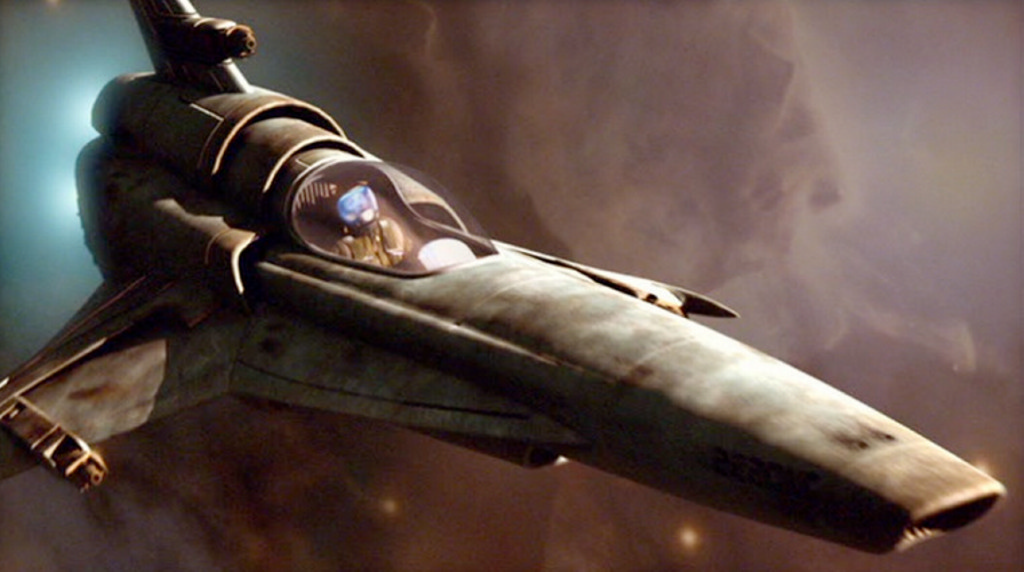Ero sivun ”Battlestar Excalibur:lentskarit” versioiden välillä
| Rivi 18: | Rivi 18: | ||
Main Weapons: 2 x MEC-A6 "Fang" 30mm Thraxon forward-firing kinetic energy weapons (KEW) mounted in the wing roots with 800 round magazine<br> | Main Weapons: 2 x MEC-A6 "Fang" 30mm Thraxon forward-firing kinetic energy weapons (KEW) mounted in the wing roots with 800 round magazine<br> | ||
Optional Armaments: Dorsal pod for 8 x HD-70 Lightning Javelin missiles and/or up to 2x50 megaton nuclear warhead.<br> | Optional Armaments: Dorsal pod for 8 x HD-70 Lightning Javelin missiles and/or up to 2x50 megaton nuclear warhead.<br> | ||
| − | Status: Decommissioned | + | Status: Decommissioned <br> |
Length: 8.4m<br> | Length: 8.4m<br> | ||
Height: 2.7m<br> | Height: 2.7m<br> | ||
| Rivi 24: | Rivi 24: | ||
Although designed over 40 years ago, the Viper Mark II remains an outstanding interceptor and space superiority fighter that's proved more than capable of matching the Cylon raider in speed, agility and firepower. | Although designed over 40 years ago, the Viper Mark II remains an outstanding interceptor and space superiority fighter that's proved more than capable of matching the Cylon raider in speed, agility and firepower. | ||
| − | |||
==Viper mark III== | ==Viper mark III== | ||
Versio 25. heinäkuuta 2013 kello 05.54
Sisällysluettelo
Viper Mark I
The Colonial Viper was the primary space superiority fighter and attack craft deployed by the Colonial military. Capable of both atmospheric and long-range spacial flight, the Viper is a single-pilot craft with two-forward mounted guns as standard.
Mark I can not carry missiles.
This model is completely retired from service.
Viper mark II
FTL No
Propulsion: 1 x Voram VM2-D15 upper turbo-thrust engine, 2x Voram VM3-D22 turbo-thrust engines, 2x reverse thrust motors, RCS points.
Crew: 1 pilot
Role: Space superiority fighter
Main Weapons: 2 x MEC-A6 "Fang" 30mm Thraxon forward-firing kinetic energy weapons (KEW) mounted in the wing roots with 800 round magazine
Optional Armaments: Dorsal pod for 8 x HD-70 Lightning Javelin missiles and/or up to 2x50 megaton nuclear warhead.
Status: Decommissioned
Length: 8.4m
Height: 2.7m
Wingspan: 4.7m
Although designed over 40 years ago, the Viper Mark II remains an outstanding interceptor and space superiority fighter that's proved more than capable of matching the Cylon raider in speed, agility and firepower.
Viper mark III
Successor of the Viper Mark II and a precursor to fighters used by the Fleet following the war, including the Viper Mark VII.
Masterpiece of engineering to some, unnecessarily complicated to others. The Mk III has six engines instead of three. The thought is that several engines could be knocked out before the Mk III was rendered worthless, also at least in theory, smaller engines are more efficient.
As with the Mark II kinetic weapons are used.
Missile armament is the same, but can fire two missiles at once. Mark III can not carry nukes.
A marked return to the Mk I chassis (due to post-war cutbacks) allowed Mk IIIs to be produced rather cheaply. Unfortunately the final product is deemed a failure by many, as its engine system is cluttered with thrust transfer vents and it boasts a nightmarish computerized engine control system.
Viper Mark IV
The Mk IV is a revolutionary design. It is designed from the ground up to be a hybrid space/atmospheric versatility fighter. It has three engines and two KEWs.
As a hybrid fighter/ground support Mark IV carries no missiles but can carry a reasonable bomb load.
The biggest change is a force induction hood that surrounds the cockpit letting air straight into the engines. This Viper is much more efficient in atmosphere burning only a quarter of the Tylium fuel needed to do the same run in a Mk II.
Viper Mark V
The Mk V (scorpion) is the heaviest, most dangerous Viper to date.
Designed and first produced in Scorpia.
Mark V is armed with 6 wing mounted KEWs, 24 missiles and a heavy bomb load (including up to 2x50 megaton nuclear bombs)
The problem is that while powerful and with heavy armor Mark V is rather massive leading to maneuverability problems.
Due to its mass its first battles were disasters in atmo Mk IVs could fly circles around the Mk V’s.
Worse it literally “fell out of the sky” when not flown by an expert pilot in atmo. In space the turn radius was larger than those of early Raptors making them durable yet easy kills.
Eventually Scorpia Arms increased the wing surfaces and added heavier reaction control thrusters improving over some of the problems. However, the upgrade cost is steep and few Mk 5's were ever upgraded.
Viper Mark VI
Mark VI is more accurately a prototype of Mk VII. Few were ever produced.
Mark VI is tremendously fast dedicated space superiority fighter with light arms and armor. It carries two KEWs and two missiles.
Viper mark VII
The Epaphus Fleet Systems Viper MkVII is a Colonial multirole aerospace fighter, originally developed by Kobol Military Industries.
Designed as a replacement for aging Viper designs, the Mark VII is a versatile craft which can carry most forms of Colonial ordinance. The Mark VII's sophisticated fly-by-wire and computer-managed systems push the envelope of fighter maneuverability.
The Mark VII is the most successful Colonial fighter program, with over 4,000 craft produced. The pinnacle of current fighter design, the Mark VII will proudly serve the Colonial Fleet for decades to come.
Mark VII is slightly larger than earlier Viper models (9.9m) and more heavily armoured.
Mark VII carries two missile launchers with capacity of 10 HD-70 Lightning Javelin missiles each and can be fitted with HD-51 Arbalest, AGM-41 Whiplash, MRT-N 2.3 Mangonel, TGB-102 Petardo or TM-7 Pyro Javelin missiles.
